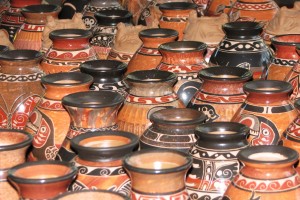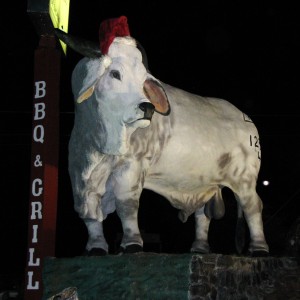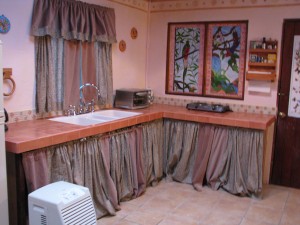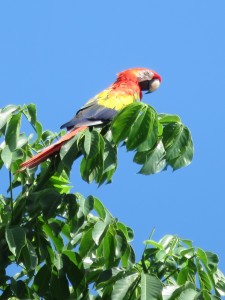 The Osa Peninsula has always been a rustic place. But that is a good thing. National Geographic magazine spent some time here a dozen or so years ago, and called Corcovado National Park the “most biologically diverse place on earth”. High praise indeed. But I think it could be true. We have always enjoyed our visits here.
The Osa Peninsula has always been a rustic place. But that is a good thing. National Geographic magazine spent some time here a dozen or so years ago, and called Corcovado National Park the “most biologically diverse place on earth”. High praise indeed. But I think it could be true. We have always enjoyed our visits here.
Though I have had to warn my less experienced travelers that this is a remote place. Sometimes, the accommodations can be rustic and food choices limited. You can go a whole day without power. But the payoff is the dazzling variety of nature and world class hiking in the primary rainforest. My advice has always been to “suck it up”, deal with some of the issues and just get out there. It is worth it in the end.
A huge exception to this rule has always been Casa Corcovado. I tell my guests that the folks here make going to an unforgiving environment as comfortable as possible. I also tell them that this lodge is very well run, and fires on all eight cylinders. My guest reviews have consistently been very positive.
We like to inspect every property we offer at least once every couple of years. More often than that if we happen to be in the region. We have been in business since 1992, and we have a pretty good network of suppliers. So most hotels are gracious enough to offer us a short stay to get to know their property, so that I can properly represent it to our clients.
If I stay in a hotel for a few days, I will always take a day to check out what might be new and interesting in the area. I also look in on my existing suppliers to make sure that they are still offering a consistent product.
But this is a tough one. Getting to this part of the Osa requires round trip airplane and boat rides. When you stay at any of the lodges down here, food has to be included. Most of the time, there are tours included too. There really aren’t any other options, so it all becomes part of the package. A free room for a night is one thing. But these extra expenses make it hard for me to ask for a freebie just so we can come down and look around. Consequently, I had not been onsite at Casa Corcovado in a decade.
I have worked with the management team here for years. The owner Steve and his manager in San Jose, Geovanny have always been terrific. Most of our contact is with the folks in the reservations department. We always find everyone on their team to be extremely professional. But more than anything, they are also just really nice folks, and a pleasure to work with. When Geovanny heard I might want to come down with my wife, he immediately invited us. Of course, we gratefully accepted.
When the day came, we flew down from San Jose on Sansa. We had fun flying along the coast and snapping pictures of Manuel Antonio from the air. We were greeted at the Palmar Sur airport by Jacob, who was to be our guide for the next three days. He 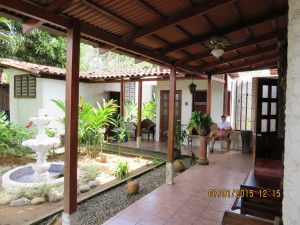 packed us into the van, and we drove through the plantations to the lodge’s “Hacienda” welcome center on the Rio Sierpe. This was our chance to relax for a few minutes with a cool beverage, use the restroom, etc. We sat at a table on the river and watched the local boat traffic. Everything from modern boats used by the lodges, to some old fishing boats that didn’t look very seaworthy at all! We waited here while some other staff members arrived to begin their stay at the lodge. They all have their own schedules. They commute in and out, and stay for days or weeks at a time. We had a pretty full boat by the time we pulled away from the dock.
packed us into the van, and we drove through the plantations to the lodge’s “Hacienda” welcome center on the Rio Sierpe. This was our chance to relax for a few minutes with a cool beverage, use the restroom, etc. We sat at a table on the river and watched the local boat traffic. Everything from modern boats used by the lodges, to some old fishing boats that didn’t look very seaworthy at all! We waited here while some other staff members arrived to begin their stay at the lodge. They all have their own schedules. They commute in and out, and stay for days or weeks at a time. We had a pretty full boat by the time we pulled away from the dock.
We rode down the river towards Drake Bay. The driver diverted from the main river and into the mangroves that grow thick along the river near the ocean. We slowly navigated the narrow canals, while Jacob explained the importance of the mangroves in the local ecosystem. Very cool. I’ve been in a mangrove forest before. But these were extensive.
We eventually cleared the river mouth and crossed Drake Bay to make a landing at the beach in front of Casa Corcovado. It was high tide, and we had to roll up our shorts and hop out into knee deep water. But nothing too difficult, and the guides stayed close to prevent any mishap. We hadn’t even reached the lodge yet, and we were already enjoying our adventure. We left our luggage to the staff, and boarded the tram (actually a trailer pulled by a tractor) that took us up to the lodge for lunch.
Wow. Things had changed. One of the things that I have always appreciated about Steve, is that he is not a guy who is content to lay on a beach. He always has a new project, or an idea to improve the guest experience. He closes the lodge for two and a half months during the rainiest months of the year. The staff members that want to take vacations, do so at this time. But the lodge employs a lot of local folks who depend on the lodge to support their families. They can’t afford a ten week vacation. So they are welcome to stay on to help with Steve’s many projects and general maintenance
Since I had stayed here ten years ago, there have been massive improvements to this already stellar lodge. There was a new pool to compliment the existing spring fed pool. The open air bar had been expanded and is now used for lunch and dinner when there is low occupancy. The old kitchen building is gone, and replaced by a beautiful new restaurant with high ceilings and stained glass windows. The staff area has been improved for their comfort, and all of the guest bungalows have been enlarged and reconfigured. They have also built some new Jr. Suites for family groups. They have improved their trail access, and rebuilt their little sunset rancho where drinks are served every evening. Oh yes, they are off the grid and generate their own reliable electricity. We were blown away. This wasn’t even the same facility from ten years ago.
After a delicious lunch and brief orientation, we were shown to our Honeymoon bungalow. It was stunning. There was a huge four poster bed with high quality linens. There was a large vanity area with closet and shelf space. The commode was in it’s own water closet, and there was a huge outdoor shower (with hot water, of course). This was lots of fun. It was lit with blue LEDs, and was a great place to shower and look at the stars. There was also the usual compliment of quality grooming products and a stocked honor bar. Not bad for the middle of the rainforest! I do have to mention that their fragile power system can’t support air conditioning. But the evenings cool down quite a bit, and we survived very well with the strong ceiling fan over the bed.
Our luggage had been brought up from the boat, and placed in the bungalow. We had some free time to move in, then put on our bathing suits to check out the new pool. We enjoyed a beverage and lounged about for an hour or so, before going back to our room to change.
By then, it was time to stroll down to the sunset rancho for a margarita before dinner. This became a ritual every evening. This is an active place. Plan on expending a lot of energy having fun here. A beautiful sunset and adult beverage is always a great way to finish a busy day. They serve some good boca’s (appetizers) at the rancho too.
We happened to hit the lodge during a lull and there were only two other people at dinner. They were leaving the next morning. So we had the place pretty much to ourselves. Jacob stopped by to give us the plan for the next day. We were going on a day long hike in Corcovado National Park. The lodge was bringing us lunch at the ranger station. It was going to be just the two of us and Jacob. A private tour.
We were up early the next morning for a delicious breakfast. The meals here are not buffets, we could order whatever we wished from the menu. Jacob was waiting when we finished. We went over to the “guide shack” to be outfitted 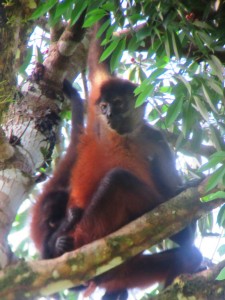 with rubber boots and walking sticks. Off we went into the woods. It was muddy, and there was a fresh fallen tree blocking one of the paths. But it was easy enough to get around. This day was so much fun. Jacob was an excellent guide and interesting guy. Smart and well traveled. He knew his stuff, and seemed happy to realize that we wanted to know everything we could. He worked really hard at finding all sorts of flora and fauna. We soaked it up. Birds, monkeys, poison dart frogs, odd trees, fruits, insects, and flowers. It was a great morning. We stopped for an hour at the ranger station for lunch. Jacob cut
with rubber boots and walking sticks. Off we went into the woods. It was muddy, and there was a fresh fallen tree blocking one of the paths. But it was easy enough to get around. This day was so much fun. Jacob was an excellent guide and interesting guy. Smart and well traveled. He knew his stuff, and seemed happy to realize that we wanted to know everything we could. He worked really hard at finding all sorts of flora and fauna. We soaked it up. Birds, monkeys, poison dart frogs, odd trees, fruits, insects, and flowers. It was a great morning. We stopped for an hour at the ranger station for lunch. Jacob cut 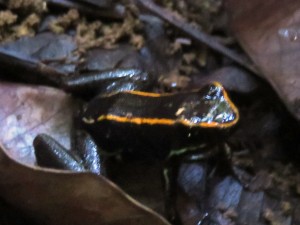 fruit and laid out our full lunch of fruit drinks, lunch meats, fresh bread (baked at the lodge), gallo pinto, cheeses, etc. He then disappeared for a short while to visit with his ranger friends. We relaxed some, and checked out the beach.
fruit and laid out our full lunch of fruit drinks, lunch meats, fresh bread (baked at the lodge), gallo pinto, cheeses, etc. He then disappeared for a short while to visit with his ranger friends. We relaxed some, and checked out the beach.
After a bit, he came back and we started our walk back along a river to the
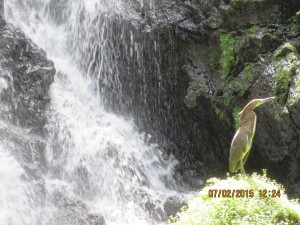 waterfall. I had been here a decade ago, and it was as beautiful as I remembered. There were several pools downstream. One of them was good for swimming. Another held a seven foot long crocodile. He was in a pool upstream from us, and Jacob assured us that it was okay. The guides apparently knew this fellow. So we took a nervous quick dip (it was hot and humid, we really wanted to cool o
waterfall. I had been here a decade ago, and it was as beautiful as I remembered. There were several pools downstream. One of them was good for swimming. Another held a seven foot long crocodile. He was in a pool upstream from us, and Jacob assured us that it was okay. The guides apparently knew this fellow. So we took a nervous quick dip (it was hot and humid, we really wanted to cool o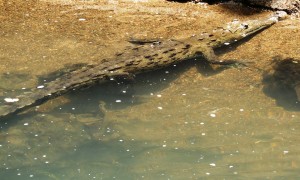 ff). Jacob didn’t join us. But I did notice that he had positioned himself where he could keep an eye on both us and our croc friend. So I felt a little better.
ff). Jacob didn’t join us. But I did notice that he had positioned himself where he could keep an eye on both us and our croc friend. So I felt a little better.
We eventually headed back to the lodge the same way we had come. When we arrived back at the ranger station, we found several huge scarlet macaws foraging in a tree. We were able to get very close, and take lots of pictures. When we arrived back at the lodge we were two very happy campers.
One quick note, this hike ain’t for wimps. Don’t get the wrong idea, it isn’t an iron man competition. But I don’t want to give the impression that this is just a stroll in the park either. I’m a middle aged (if I live to be 120) guy, who does light to moderate exercise every week. I had no problem handling it, so I think most people can do it. But this is an active destination, and it is hot and humid. We had sweat right through our clothes by lunch. You will find yourself stepping over felled trees and branches, wading in mud, and navigating the occasional narrow path. By the end of the day, we were a little worn out. But it was worth every single second.
After our hike, Melissa grabbed a shower, and went to get the massage she had booked the day before. I toured the property with the resident manager, Steven.
He showed me all the improvements, and the various accommodations. I particularly liked the Jr. Suites, which were new since my last visit. These are two adjoining one bedroom apartments each with 1½ baths. They can be combined. With the sleeper sofas open, you end up with an accommodation with two private bedrooms, two sleeping areas in the living rooms, two full baths, and two half baths. Perfect for a family group. After my tour, I went back to the pool for a dip and to wait for my wife.
Melissa came back energized and gushing about her massage. She said it was the best she ever had. I immediately booked mine for the next evening. This evening’s routine was much the same. We had drinks at the Sunset Rancho and another wonderful meal. Jacob stopped by our table to tell us we were going snorkeling at Isla del Cano the next day. A very nice couple had come in that day, and we had spied them in the pool earlier. We met them at dinner and found out that they were Costa Ricans, who were also involved in tourism. They were coming with us on our tour the next day. Jacob had also offered to take Melissa and I out on a morning bird tour before breakfast.
That night, Melissa was awakened by a horrible racket. There was some kind of animal carnage going on in the nearby woods. From her description, the guides thought that a puma or some other wildcat had gotten hold of a monkey. It goes to show how close to nature the lodge is. It also made me think about those wildlife films we have all seen. The prey always gives in so easy. That apparently wasn’t the case here. But then again, I slept through it. I’ve also once slept through an earthquake in Costa Rica. Go figure.
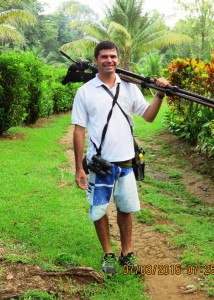 We were up early in the morning to walk the lodge property with Jacob. What a fun way to work up an appetite for breakfast. We had seen the day before that this guy had a good eye, as he was spotting animals every where. He proved it again this morning. He would hear a bird call from a couple hundred meters away, and in a half a minute he would have it sighted in on his amazing scope. We had a least a dozen good sightings, then it was time for breakfast and to board the boat to the island. Along with our boat captain and Jacob, we had the other two guests and another guide with us. We had a nice morning snorkeling with lots of colorful schools of fish. There was a beautiful little beach, and we had fun shooting a video of the hermit crabs for our grandson.
We were up early in the morning to walk the lodge property with Jacob. What a fun way to work up an appetite for breakfast. We had seen the day before that this guy had a good eye, as he was spotting animals every where. He proved it again this morning. He would hear a bird call from a couple hundred meters away, and in a half a minute he would have it sighted in on his amazing scope. We had a least a dozen good sightings, then it was time for breakfast and to board the boat to the island. Along with our boat captain and Jacob, we had the other two guests and another guide with us. We had a nice morning snorkeling with lots of colorful schools of fish. There was a beautiful little beach, and we had fun shooting a video of the hermit crabs for our grandson.
But the big adventure of the day was yet to come, as we were riding back in the boat. I was very relaxed, and quite content. I was literally thinking that I could not imagine a better day. Then a huge humpback whale breached in front of our boat. Right where I was looking. This has to be one of the most spectacular things I have ever seen. The whole boat erupted with shouts of “Whale!’ We hung around for about 15 minutes, and it surfaced a few more times. The guides were very happy. This was the first of the season, and there was a lot of chatter between the staff about it at the lodge. Once we arrived back at the lodge, we walked along the shoreline to where they had set up lunch under a palm frond pergola on their pretty little beach. We ate with our new friends, and the guides said that we were welcome to stay and swim. But I had to drag myself away. I had booked my massage with Cynthia, and I wasn’t going to miss it.
I don’t know how to describe it. How do you describe a massage? But I have to agree with Melissa. Absolutely the best massage ever. Afterwards, Cynthia had brewed some tea. Melissa joined us and we had a chance to chat. Cynthia turned out to be a delightful young woman. She had went to a massage school in San Jose, and supplemented her training with some Hungarians that hold workshops in Costa Rica from time to time. She was also a yoga instructor, and told us that she was taking her dream trip during the break. She was going to India with about 15 other yoga enthusiasts for a month. She was beaming. We beamed for her. It is always a wonderful thing to see someone follow their passion.
All in all. We were thrilled to see that Casa Corcovado had morphed into a luxury resort, with a minuscule environmental footprint. They are truly off the grid. They are generating their own electricity, purifying their own water, and dealing with their own sewage and trash. It really is an amazing model of sustainable development. The surrounding forest is untouched and the management is a responsible steward of the nature they share. They take their responsibility seriously.
We reluctantly packed up the next morning for the journey back to San Jose. We were not ready to go. We were ready to move in. We wanted to hang out with our new friends, eat great food, and hike in the woods. But our real lives were calling. So we left happy, and appreciative of the gifts working in this industry gives to us. And we hope to do another “inspection” sometime soon.
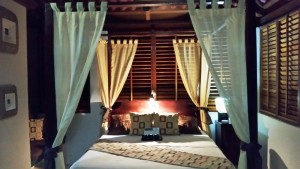
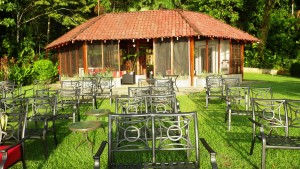
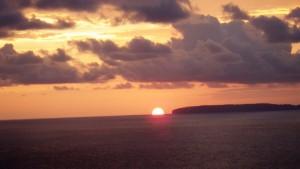
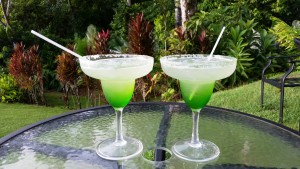
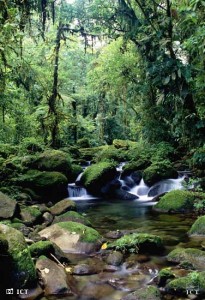
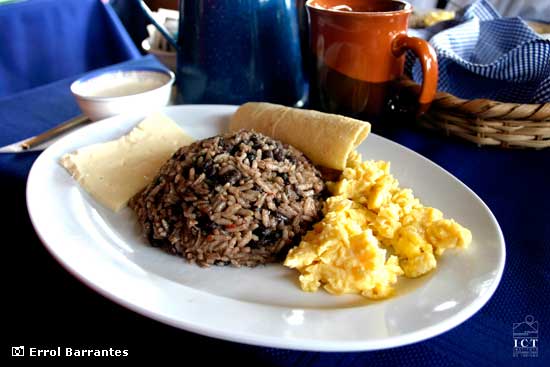 It is a typical morning in Costa Rica, and my lovely bride is craving a “Tipical” breakfast.
It is a typical morning in Costa Rica, and my lovely bride is craving a “Tipical” breakfast.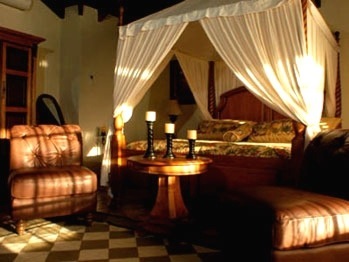 The other end of the scale was the Hotel Borinquen. For those in the $300 per night range, this place will knock you out. The rooms are beautiful and fully appointed. Great for a getaway or honeymoon. They have bubbling mud pits on site. Their sauna is actually built over one. There is a wooden slatted floor, and the steam comes up through the floor. Their spa appeared to be first rate with beautiful views into the forest. This is also built over a rushing river, that I am sure would be great background white noise to listen to during a massage. They offer different treatments with the volcanic mud. There is a very nice pool, too. The hotel offers a full compliment of hikes and horseback tours into the park. They also offered “ATV safaris” and have a pretty decent canopy tour onsite. I was only able to glance at a menu (there are two restaurants), but it looked like the chef is creative, and there were some interesting options.
The other end of the scale was the Hotel Borinquen. For those in the $300 per night range, this place will knock you out. The rooms are beautiful and fully appointed. Great for a getaway or honeymoon. They have bubbling mud pits on site. Their sauna is actually built over one. There is a wooden slatted floor, and the steam comes up through the floor. Their spa appeared to be first rate with beautiful views into the forest. This is also built over a rushing river, that I am sure would be great background white noise to listen to during a massage. They offer different treatments with the volcanic mud. There is a very nice pool, too. The hotel offers a full compliment of hikes and horseback tours into the park. They also offered “ATV safaris” and have a pretty decent canopy tour onsite. I was only able to glance at a menu (there are two restaurants), but it looked like the chef is creative, and there were some interesting options.
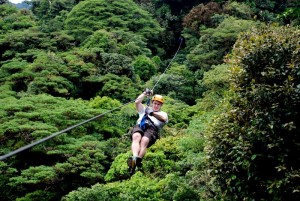 The zipline tours through the forest canopy originated as a commercial venture in Monteverde. There is some dispute about how they were invented and by whom. One of the local businesses even has a copyright on the term “canopy tour”, which has become the catch all term that many use to describe this adventuresome activity. I won’t get involved in this argument, but I will tell you that this is one of the most fun things you can do during your adventure in Costa Rica. They are scattered all over the country. But I feel that the best ones can still be found around Monteverde. There are some slight variations on the mechanics. But all are basically long cables stretching from one hilltop to another. The participant (that would be you) wears a harness, that was borrowed from rock climbing gear. There is a pulley mechanism that fits over the cable, and this attaches to your harness. You stand on a platform, lift your legs, and let gravity take over.
The zipline tours through the forest canopy originated as a commercial venture in Monteverde. There is some dispute about how they were invented and by whom. One of the local businesses even has a copyright on the term “canopy tour”, which has become the catch all term that many use to describe this adventuresome activity. I won’t get involved in this argument, but I will tell you that this is one of the most fun things you can do during your adventure in Costa Rica. They are scattered all over the country. But I feel that the best ones can still be found around Monteverde. There are some slight variations on the mechanics. But all are basically long cables stretching from one hilltop to another. The participant (that would be you) wears a harness, that was borrowed from rock climbing gear. There is a pulley mechanism that fits over the cable, and this attaches to your harness. You stand on a platform, lift your legs, and let gravity take over.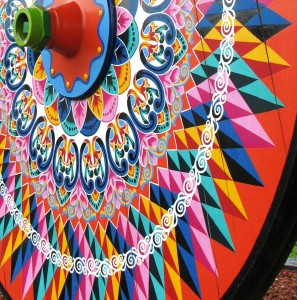 The town of Sarchi has become well known as the home of that colorful symbol of Costa Rica, the painted ox cart. Yes, miniature versions have become popular as mini bars purchased by tourists to ship home. But the history of the ox cart is much more interesting, and they have played a very important part in the economic development of this country.
The town of Sarchi has become well known as the home of that colorful symbol of Costa Rica, the painted ox cart. Yes, miniature versions have become popular as mini bars purchased by tourists to ship home. But the history of the ox cart is much more interesting, and they have played a very important part in the economic development of this country.